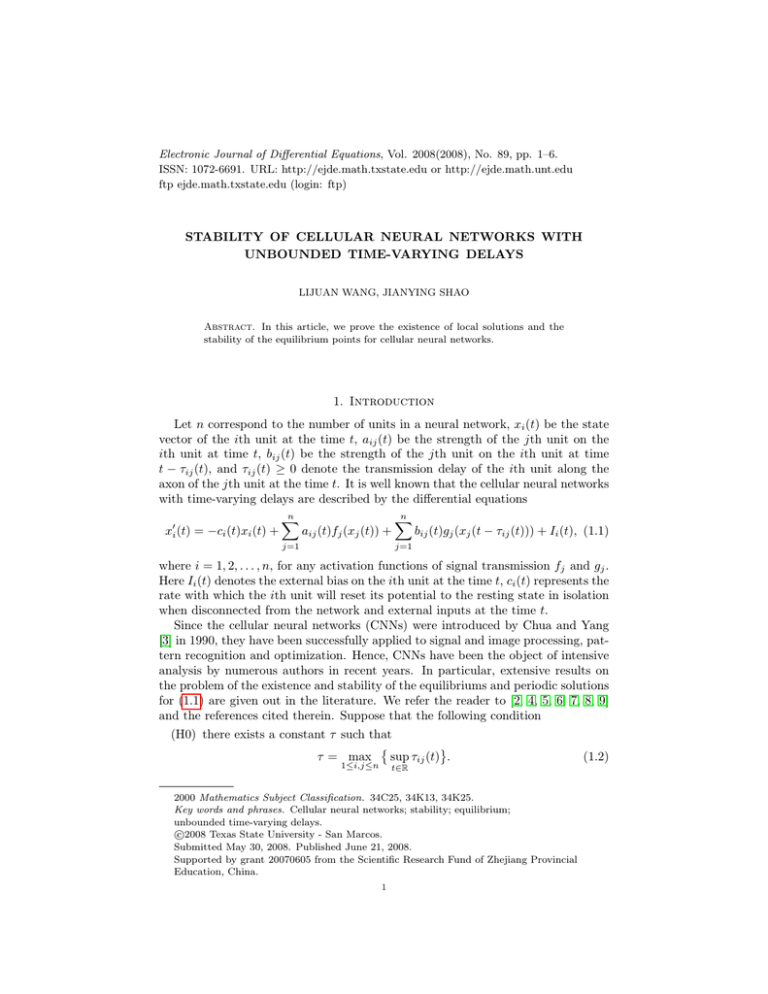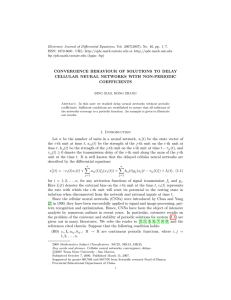Electronic Journal of Differential Equations, Vol. 2008(2008), No. 89, pp.... ISSN: 1072-6691. URL: or
advertisement

Electronic Journal of Differential Equations, Vol. 2008(2008), No. 89, pp. 1–6.
ISSN: 1072-6691. URL: http://ejde.math.txstate.edu or http://ejde.math.unt.edu
ftp ejde.math.txstate.edu (login: ftp)
STABILITY OF CELLULAR NEURAL NETWORKS WITH
UNBOUNDED TIME-VARYING DELAYS
LIJUAN WANG, JIANYING SHAO
Abstract. In this article, we prove the existence of local solutions and the
stability of the equilibrium points for cellular neural networks.
1. Introduction
Let n correspond to the number of units in a neural network, xi (t) be the state
vector of the ith unit at the time t, aij (t) be the strength of the jth unit on the
ith unit at time t, bij (t) be the strength of the jth unit on the ith unit at time
t − τij (t), and τij (t) ≥ 0 denote the transmission delay of the ith unit along the
axon of the jth unit at the time t. It is well known that the cellular neural networks
with time-varying delays are described by the differential equations
x0i (t) = −ci (t)xi (t) +
n
X
aij (t)fj (xj (t)) +
j=1
n
X
bij (t)gj (xj (t − τij (t))) + Ii (t), (1.1)
j=1
where i = 1, 2, . . . , n, for any activation functions of signal transmission fj and gj .
Here Ii (t) denotes the external bias on the ith unit at the time t, ci (t) represents the
rate with which the ith unit will reset its potential to the resting state in isolation
when disconnected from the network and external inputs at the time t.
Since the cellular neural networks (CNNs) were introduced by Chua and Yang
[3] in 1990, they have been successfully applied to signal and image processing, pattern recognition and optimization. Hence, CNNs have been the object of intensive
analysis by numerous authors in recent years. In particular, extensive results on
the problem of the existence and stability of the equilibriums and periodic solutions
for (1.1) are given out in the literature. We refer the reader to [2, 4, 5, 6, 7, 8, 9]
and the references cited therein. Suppose that the following condition
(H0) there exists a constant τ such that
τ = max
sup τij (t) .
(1.2)
1≤i,j≤n
t∈R
2000 Mathematics Subject Classification. 34C25, 34K13, 34K25.
Key words and phrases. Cellular neural networks; stability; equilibrium;
unbounded time-varying delays.
c
2008
Texas State University - San Marcos.
Submitted May 30, 2008. Published June 21, 2008.
Supported by grant 20070605 from the Scientific Research Fund of Zhejiang Provincial
Education, China.
1
2
L. WANG, J. SHAO
EJDE-2008/89
Most authors of bibliographies listed above obtained some sufficient conditions for
the existence and stability of the equilibriums and periodic solutions for system
(1.1). However, to the best of our knowledge, few authors have considered dynamic
behaviors of (1.1) without the assumption (H0). Thus, it is worth while to continue
to investigate the stability of system (1.1).
The main purpose of this paper is to give new criteria for the stability of the
equilibrium of system (1.1). By applying mathematical analysis techniques, without
assuming (H0), we derive some sufficient conditions ensuring that the equilibrium of
(1.1) is locally stable, which are new and complement of previously known results.
An example is provided to illustrate our results. In this paper, for i, j = 1, 2, . . . , n,
it will be assumed that ci (t), Ii (t), aij (t), bij (t) are constant:
ci ≡ ci (t),
Ii ≡ Ii (t),
aij ≡ aij (t),
bij ≡ bij (t).
(1.3)
It will be assumed that
max {sup τij (t)} = +∞, τij (t) < t, i, j = 1, 2, · · · , n.
1≤i,j≤n t∈R
(1.4)
We also assume that the following conditions:
(H1) For each j ∈ {1, 2, . . . , n}, there exist nonnegative constants L̃j and Lj such
that
|fj (u) − fj (v)| ≤ L̃j |u − v|,
|gj (u) − gj (v)| ≤ Lj |u − v|,
for all u, v ∈ R. (1.5)
(H2) There exist constants η > 0 and ξi > 0, i = 1, 2, . . . , n, such that
−ci ξi +
n
X
j=1
|aij |L̃j ξj +
n
X
|bij |Lj ξj < −η < 0,
i = 1, 2, . . . , n.
j=1
Since ci (t), Ii (t), aij (t), bij (t) are constant, by using a similar argument as that
in the proof of [4, Theorem 2.3], we can easily show the following lemma.
Lemma 1.1. Let (H1), (H2) hold. Then (1.1) has at least one equilibrium point.
The initial conditions associated with (1.1) are of the form
xi (s) = ϕi (s), s ∈ (−∞, 0],
i = 1, 2, . . . , n,
(1.6)
where ϕi (·) denotes real-valued bounded continuous function defined on (−∞, 0].
For Z(t) = (x1 (t), x2 (t), . . . , xn (t))T , we define the norm
kZ(t)kξ =
max
i=1,2,...,n
|ξi−1 xi (t)|.
(1.7)
The remaining part of this paper is organized as follows. In Section 2, we present
sufficient conditions to ensure that the equilibrium of system (1.1) is locally stable.
In Section 3, we give some examples and remarks to illustrate our results obtained
in the previous sections.
2. Main Results
Theorem 2.1. Assume (H1), (H2) hold. Suppose that Z ∗ = (x∗1 , x∗2 , . . . , x∗n )T is
the equilibrium of (1.1). Then, Z ∗ is locally stable, namely, for all ε > 0, there
exists a constant δ > 0 such that for every solution Z(t) = (x1 (t), x2 (t), . . . , xn (t))T
of (1.1) with any initial value ϕ = (ϕ1 (t), ϕ2 (t), . . . , ϕn (t))T such that
kϕ − Z ∗ k = max { sup
1≤j≤n −∞≤t≤0
|ϕj − Zj∗ |} < δ,
EJDE-2008/89
STABILITY OF CELLULAR NEURAL NETWORKS
3
there holds
|xi (t) − x∗i | < ε,
for all t ≥ 0, i = 1, 2, . . . , n.
Proof. Let Z(t) = (x1 (t), x2 (t), . . . , xn (t))T be a solution of system (1.1) with any
initial value ϕ = (ϕ1 (t), ϕ2 (t), . . . , ϕn (t))T , and define
u(t) = (u1 (t), u2 (t), . . . , un (t))T = Z(t) − Z ∗ .
Then
u0i (t) = −ci ui (t) +
n
X
aij [fj (xj (t)) − fj (x∗j )] +
j=1
n
X
bij [gj (xj (t − τij (t))) − gj (x∗j )],
j=1
(2.1)
where i = 1, 2, . . . , n. Let it be an index such that
|uit (t)| = ku(t)kξ .
ξi−1
t
(2.2)
Calculating the upper right derivative of |uis (s)| along (2.1), in view of (2.1) and
(H1), we have
D+ (|uis (s)|)
s=t
n
n
X
= sign(uit (t)) − cit uit (t) +
ait j [fj (xj (t)) − fj (x∗j )]
j=1
+
n
X
o
bit j [gj (xj (t − τit j (t))) − gj (x∗j )]
j=1
≤
−cit |uit (t)|ξi−1
ξ it
t
+
n
X
(2.3)
ait j L̃j |uj (t)|ξj−1 ξj
j=1
+
n
X
bit j Lj |uj (t − τit j (t))|ξj−1 ξj .
j=1
Let
M (t) = max{ku(s)kξ }.
s≤t
(2.4)
It is obvious that ku(t)kξ ≤ M (t), and M (t) is non-decreasing. Now, we consider
two cases.
Case (i).
M (t) > ku(t)kξ
for all t ≥ 0.
(2.5)
We claim that M (t) ≡ M (0) is constant for all t ≥ 0. By way of contradiction,
assume that this is not the case. Consequently, there exists t1 > 0 such that
M (t1 ) > M (0). Since
ku(t)kξ ≤ M (0)
for all t ≤ 0.
There must exist β ∈ (0, t1 ) such that
ku(β)kξ = M (t1 ) ≥ M (β),
which contradicts (2.5). This contradiction implies that M (t) is constant and
ku(t)kξ < M (t) = M (0)
for all t ≥ 0.
(2.6)
4
L. WANG, J. SHAO
EJDE-2008/89
Case (ii). There is a point t0 ≥ 0 such that M (t0 ) = ku(t0 )kξ . Then, using the
(2.1) and (2.3), for all ε > 0, we obtain
D+ (|uis (s)|)
s=t0
≤ −cit0 |uit0 (t0 )|ξi−1
ξit0 +
t
n
X
0
ait0 j L̃j |uj (t0 )|ξj−1 ξj
j=1
+
n
X
bit0 j Lj |uj (t0 − τit0 j (t0 ))|ξj−1 ξj
j=1
n
n
X
X
≤ − cit0 ξit0 +
ait0 j L̃j ξj +
bit0 j Lj ξj M (t0 )
j=1
j=1
< −ηM (t0 ) + η min {ξj−1 }ε .
1≤j≤n
In addition, if M (t0 ) ≥ min1≤j≤n {ξj−1 }ε, then M (t) is strictly decreasing in a small
neighborhood (t0 , t0 + δ0 ). This contradicts that M (t) is non-decreasing. Hence,
ku(t0 )kξ = M (t0 ) < min {ξj−1 }ε.
(2.7)
1≤j≤n
Furthermore, for any t > t0 , by the same approach used in the proof of (2.7), we
have
ku(t)kξ < min {ξj−1 }ε,
1≤j≤n
if M (t) = ku(t)kξ .
(2.8)
On the other hand, if M (t) > ku(t)kξ , t > t0 . We can choose t0 ≤ t3 < t such that
M (t3 ) = ku(t3 )kξ < min {ξj−1 }ε,
1≤j≤n
M (s) > ku(s)kξ
for all s ∈ (t3 , t].
Using a similar argument as in the proof of Case (i), we can show that M (s) ≡ M (t3 )
is constant for all s ∈ (t3 , t], which implies that
ku(t)kξ < M (t) = M (t3 ) = ku(t3 )kξ < min {ξj−1 }ε.
1≤j≤n
In summary, for all t ≥ 0, we obtain
ku(t)kξ < max M (0), min {ξj−1 }ε .
1≤j≤n
(2.9)
Hence, for ε > 0, set
δ=
min1≤j≤n {ξj−1 }
max1≤j≤n {ξj−1 }
> 0.
Then, for every solution Z(t) = (x1 (t), x2 (t), . . . , xn (t))T of (1.1) with any initial
value ϕ = (ϕ1 (t), ϕ2 (t), . . . , ϕn (t))T and
kϕ − Z ∗ k = max
sup |ϕj − Zj∗ | < δ,
1≤j≤n
−∞≤t≤0
in view of (2.9), we have |xi (t) − x∗i | < ε, for all t ≥ 0, i = 1, 2, . . . , n. This
completes the proof.
EJDE-2008/89
STABILITY OF CELLULAR NEURAL NETWORKS
5
3. An Example
To illustrate the results obtained in previous sections, consider the CNNs, with
unbounded time-varying delays,
1
1
1
1
x01 (t) = −x1 (t) + f1 (x1 (t)) + f2 (x2 (t)) + g1 (x1 (t − |t sin t|))
4
36
4
2
1
1
+ g2 (x2 (t − |t sin t|)) + 1,
36
3
(3.1)
1
1
0
x2 (t) = −x2 (t) + f1 (x1 (t)) + f2 (x2 (t)) + g1 (x1 (t − |t sin t|))
4
4
1
1
+ g2 (x2 (t − |t sin t|)) + 2,
4
5
where f1 (x) = f2 (x) = g1 (x) = g2 (x) = arctan x. Note that
1
c1 = c2 = L1 = L2 = L̃1 = L̃2 = 1, a11 = b11 = ,
4
1
1
, a21 = b21 = 1, a22 = b22 = .
a12 = b12 =
36
4
Then
1
1/2 1/18
dij = (aij L̃j + bij Lj ) i, j = 1, 2, D = (dij )2×2 =
.
2
1/2
ci
Hence, we have ρ(D) = 65 < 1. Therefore, it follows from theory of M -matrix in [1]
that there exist constants η > 0 and ξi > 0, i = 1, 2, such that for all t > 0, there
holds
2
2
X
X
−ci ξi +
|aij |L̃j ξj +
|bij |Lj ξj < −η < 0, i = 1, 2,
j=1
j=1
which implies that (3.1) satisfied (H1) and (H2). Hence, from Lemma 1.1 and
Theorem 2.1, system (3.1) has at least one equilibrium Z ∗ , and Z ∗ is locally stable.
We remark that since (3.1) is a cellular neural networks with unbounded timevarying delays, the results in [2, 4, 5, 6, 7, 8, 9] can not be applied to prove that the
equilibrium point is locally stable. Thus, the results of this paper are essentially
new.
References
[1] A. Berman and R. J. Plemmons: Nonnegative Matrices in the Mathematical Science, Academic
Press, New York, 1979.
[2] Q. Liu and J. Cao; Improved global exponential stability criteria of cellular neural networks
with time-varying delays, Mathematical and Computer Modelling, 43 (2006) 423-432.
[3] L. O. Chua, T. Roska; Cellular neural networks with nonlinear and delay-type template elements, in: Proc. 1990 IEEE Int. Workshop on Cellular Neural Networks and Their Applications, 1990, pp. 12-25.
[4] L. Huang, C. Huang and B. Liu; Dynamics of a class of cellular neural networks with timevarying delays, Physics Letters A, 345 (4-6) (2005) 330-344.
[5] Teh-Lu Liao, Jun-Juh Yan, Chao-Jung Cheng and Chi-Chuan Hwang; Globally exponential
stability condition of a class of neural networks with time-varying delays, Physics Letters A,
339 (3-5) (2005) 333-342.
[6] Z. Liu and L. Liao; Existence and global exponential stability of periodic solutions of cellular
neural networks with time-vary delays, Journal of Mathematical Analysis And Applications,
290 (2) (2004) 247-262
[7] B. Liu and L. Huang; Existence and exponential stability of periodic solutions for cellular
neural networks with time-varying delays, Physics Letters A, 349 (2006) 474-483 .
6
L. WANG, J. SHAO
EJDE-2008/89
[8] W. Lu and T. Chen; On periodic Dynamical systems, Chinese Annals of Mathematics, B(25)
(2004) 455-462.
[9] K. Yuan, J. Cao and J. Deng; Exponential stability and periodic solutions of fuzzy cellular
neural networks with time-varying delays, Neurocomputing, 69 (2006) 1619-1627.
Lijuan Wang
College of Mathematics and Information Engineering, Jiaxing University, Jiaxing, Zhejiang 314001, China
E-mail address: wanglijuan1976@yahoo.com.cn
Jianying Shao
College of Mathematics and Information Engineering, Jiaxing University, Jiaxing, Zhejiang 314001, China
E-mail address: shaojianying2008@yahoo.cn






